What is Electromagnetic Induction?
Principles and Worked Examples
Electromagnetic (EM) induction occurs when an electromagnetic field (emf) is induced in a wire, or more precisely when a complete loop of wire cuts across lines of a magnetic field; the movement induces a current and therefore an emf.
The emf can be increased by moving the wire faster, using a stronger magnet and making wires into a coil and ensuring that the wires cut across the field at 90 degrees.
The direction of the current induced is dependant on the direction of the magnetic field.
A current carrying wire

We can determine the direction of the field using the Right hand ‘screw’ rule for B field around a current carrying wire. The thumb represents the direction of the current and the fingers curve to follow the direction of the magnetic field.
A Solenoid

Solenoid Poles
The poles of a solenoid can be determined using the right hand screw rule and knowing that field lines always come out of the north pole and into the south.
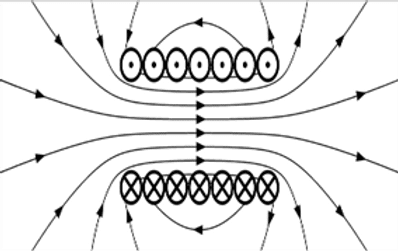
Magnetic field
When drawing the magnetic field lines around a solenoid the crosses represent wires going into the page and the dots out of the page.
A magnetic field will also change the direction of a moving charge.
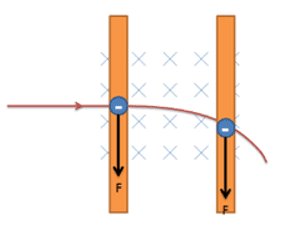
Moving Charge
When a charge moves through a magnetic field we are able to define conventional current and when the charge is confined within a wire a potential difference is induced and electrons will flow in a complete circuit.
Faraday and Lenz’s Law
There are two main laws relating to Magnetism
Lenz’s law = “the direction of the induced current is always such that it opposes the change that causes the current”.
Faraday’s law = “the induced emf in a circuit is equal to the rate of change of magnetic flux linkage through the circuit”.
Lenz’s Law
When a bar magnet is pushed into a coil of wire, an ammeter will show a reading, and when pulled out the meter deflects in the opposite direction. The induced current passing round the circuit creates a magnetic field around the coil.
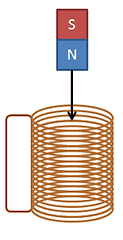
Coil Field
The coil field must oppose the incoming north pole otherwise it would pull the north pole in faster;
- As the magnet enters the coil, the top of the coil becomes a north pole, this magnetic field will oppose the movement of the bar magnet.
- As the magnet leaves, the south pole will induce a north pole in the bottom of the coil
Magnetic Flux and Linkage
Flux linkage is the linking of the magnetic field with the conductors of a coil when the magnetic field passes through the loops of the coil, expressed as a value. The flux linkage of a coil is simply the alternative term for the total flux, used for convenience in engineering.
Magnetic flux, Φ, is defined as:

The unit of Magnetic Flux is the Weber. Where ‘A’ is the area swept out = lΔs. The Magnetic Flux linkage through a coil of N turns is:

When the magnetic field is at an angle the equation becomes:
ФN = NBA cos θ
Where
- B =magnetic field, in Tesla (T)
- A = cross sectional area, in metres squared (m^2)
- N = number of coils
Since emf is the rate of change of magnetic flux x number of coils of wire, we get Lenz’s Law
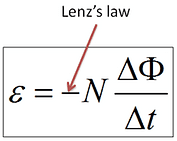
Example. Calculate the magnitude of the induced emf when the magnet is thrust into the coil, given the following information: the single loop coil has a radius of 6.00 cm and the average value of B cosθ (this is given, since the bar magnet’s field is complex) increases from 0.0500 T to 0.250 T in 0.100 s.
Solution: To find the magnitude of emf, we use Faraday’s law of induction as stated by Emf = − NΔϕ Δt but without the minus sign that indicates direction: emf = N Δϕ Δt We are given that N=1 and Δt = 0.100s but we must determine the change in flux Δϕ before we can find emf. Since the area of the loop is fixed, we see that Δϕ = Δ(BA cosθ) = Δϕ = AΔ(B cosθ) Now Δ(B cosθ) = 0.200T, since it was given that B cosθ changes from 0.0500 to 0.250 T. The area of the loop is A = πr^2 = (3.14…)(0.060m)^2 = 1.13×10^−2 m^2 Thus, Δϕ = (1.13×10^−2 m^2)(0.200T) Entering the determined values into the expression for emf gives Emf = N Δϕ = (1.13×10^−2 m^2)(0.200T) = 22.6mV Δt 0.100s
Dropping a Magnet into a Coil
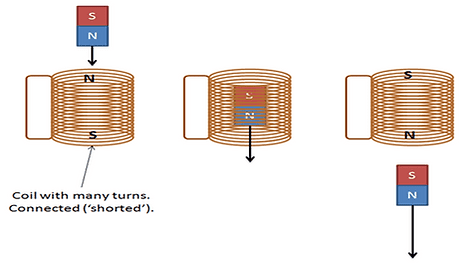
Moving Magnet
- As the magnet enters, it induces a current in the loop that sets up a magnetic field to oppose the entry of the magnet
- When the magnet is in the middle of the coil it is at the point where the magnetic poles will switch. At this point there is no current flowing in the coil since the p.d is zero.
- When exiting the coil, the magnet is moving faster and it induces a current in the loop that sets up a magnetic field to oppose the magnet moving away i.e. the magnetic poles of the coil change.
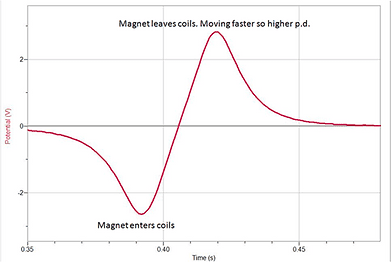
p.d against time
Note: The p.d will be higher when leaving the coil as it will be moving quicker since it has been accelerated due to gravity.
This is because the magnet is moving faster as it exits and thus the rate of change in magnetic flux linkage is greater when it exits.
The p.d. changes direction because the current and the magnetic fields both switch to oppose the changes that occur.
Faraday´s Law

Wire in Conductor
A length of wire, l, is part of a complete circuit cutting through a magnetic field of flux density, B
The conductor experiences a force of F= BIL. The force opposes the motion (Lenz’s law).
An equal and opposite force is needed for constant speed in the field
Work done can be calculated by force x distance, but force = BIL, so we can combine the equations to give (where ∆ means change)

We can also calculate the charge in the conductor

Since emf can be calculated by work done divided by charge, we get the following equations

Finally, since velocity = displacement / time

This was Faraday’s Law
Therefore, the induced emf in a circuit is equal to the rate of change of magnetic flux linkage through the circuit (Faraday). The direction of the induced current is always such that it opposes the change that causes the current (Lenz). The opposing change is represented by the negative sign in the equation:


Example 1: A conducting loop in the form of a circle placed perpendicular to a magnetic field of 0.80 T. if the radius of the loop increases from 10 cm to 20 cm in 1s, what is the induced emf in the loop?
Solution: We are given the following data: The magnitude of the magnetic field is B =0.8T. The initial radius of the loop is r1 = 10cm = 0.1m. The final radius of the loop is r2 = 20cm = 0.2m . The time is t = 1s. The expression for the induced emf in the loop is, ε = BA = B(πr2^2−πr1^2) t t Substituting the given values in the above expression, we will get ε = (0.8T)π((0.2m)^2−(0.1m)^2) 1s ε = 0.07539V ≈ 0.075V Thus, the induced emf in the loop is 0.075V Example 2: Consider a solenoid of 9 turns with unknown radius, r. The solenoid is subjected to a magnetic field of 0.12 T. The axis of the solenoid is parallel to the magnetic field. When the field is uniformly switched to 12 T over a period of 2 minutes an emf with a magnitude of −0.3 V is induced. Determine the radius of the solenoid.

Start with Faraday’s Law ε = − NΔϕ Δt The area, A, is the surface area of the solenoid which is πr^2. Solution:

Interested in electrical and electronic engineering? Find out more about all the electrical engineering courses we have available by clicking here.
Diploma in Electrical Technology
Diploma in Renewable Energy (Electrical)
Diploma in Electrical and Electronic Engineering
Alternatively, you can view all our online engineering courses here.
Recent Posts
From Raw Material to Refined Component: The Role of Drilling and Turning
From Raw Material to Refined Component: The Role of Drilling and Turning Secondary processes are used in manufacturing to further modify the output of primary manufacturing processes in order to improve the material properties, surface quality, surface integrity, appearance and dimensional tolerance. In this blog, we will focus on drilling and turning as secondary manufacturing […]
Behind the Cutter: How Milling Shapes the Future of Manufacturing
Behind the Cutter: How Milling Shapes the Future of Manufacturing Secondary processes are used in manufacturing to further modify the output of primary manufacturing processes in order to improve the material properties, surface quality, surface integrity, appearance and dimensional tolerance. In this blog, we will focus on milling as a secondary manufacturing process. Machining refers […]
What is joining and why is it important in Engineering?
What is joining and why is it important in Engineering? Joining can be considered the third primary manufacturing process, it is an important step in the manufacture of parts with complex shapes, or unusual geometric features. Using the primary processes of casting and forming, it may not be technically or economically feasible to create parts […]

